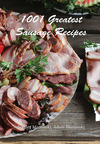Meats and Sausages
Dry Fruit Infusion
Infusions can be made from dry fruit such as raisins, prunes, plums, apricots, figs, juniper, vanilla, rowan, blackthorn, wild rose and others. Dry fruits contain little water but plenty of sugar and concentrated substances that can be extracted. To fully extract ingredients from dry fruit the first and second infusion methods are usually applied. Dry fruits contain almost no juice so the alcohol will not be very diluted. Therefore, a larger amount of weaker alcohol is added. Whereas in the case of fresh fruit we may expect to obtain about 1.5 liters of infusion from 1 kg of fruit, processing 1 kg of dry fruit will usually result in 3-4 liters infusion as more alcohol is added.
The process:
- Soaking dry fruit for 12-24 hours in little water (optional step).
- The first infusion - covering fruit with 3 liters 50% alcohol (per 1 kg of fruit).
- Macerating for 2-3 weeks.
- Siphoning the infusion.
- The second infusion - adding 1.5 - 1.75 liters 40% alcohol (per 1k of fruit).
- Macerating for 2-3 weeks.
- Siphoning the infusion and filtering the must. Cover the container to prevent alcohol evaporation. The first and the second infusions are combined together.
The following table can be used as a point of reference as it reflects the methods used by commercial producers.
Making infusions from 1 kg of dry fruit
First Infusion
| Material | Alcohol (liter) | Alcohol (%) | Time |
|---|---|---|---|
| Bird Cherry (Padus avium) | 3 | 50 | 4 weeks |
| Blackthorn | 2 | 50 | 3 weeks |
| Figs | 5 | 50 | 3 weeks |
| Prunes | 5 | 50 | 3 weeks |
| Raisins | 5 | 50 | 3 weeks |
| Raspberries | 5 | 50 | 3 weeks |
| Rowan | 8 | 60 | 3 weeks |
| Vanilla | 10 | 60 | 3 weeks |
Second Infusion
| Material | Alcohol (liter) | Alcohol (%) | Time |
|---|---|---|---|
| Bird Cherry (Padus avium) | 1.5 | 40 | 3 weeks |
| Blackthorn | 0.9 | 40 | 3 weeks |
| Figs | 3 | 40 | 3 weeks |
| Prunes | 3 | 40 | 3 weeks |
| Raisins | 3 | 40 | 3 weeks |
| Raspberries | 3 | 40 | 3 weeks |
| Rowan | 5 | 40 | 3 weeks |
| Vanilla | 7 | 40 | 3 weeks |

















